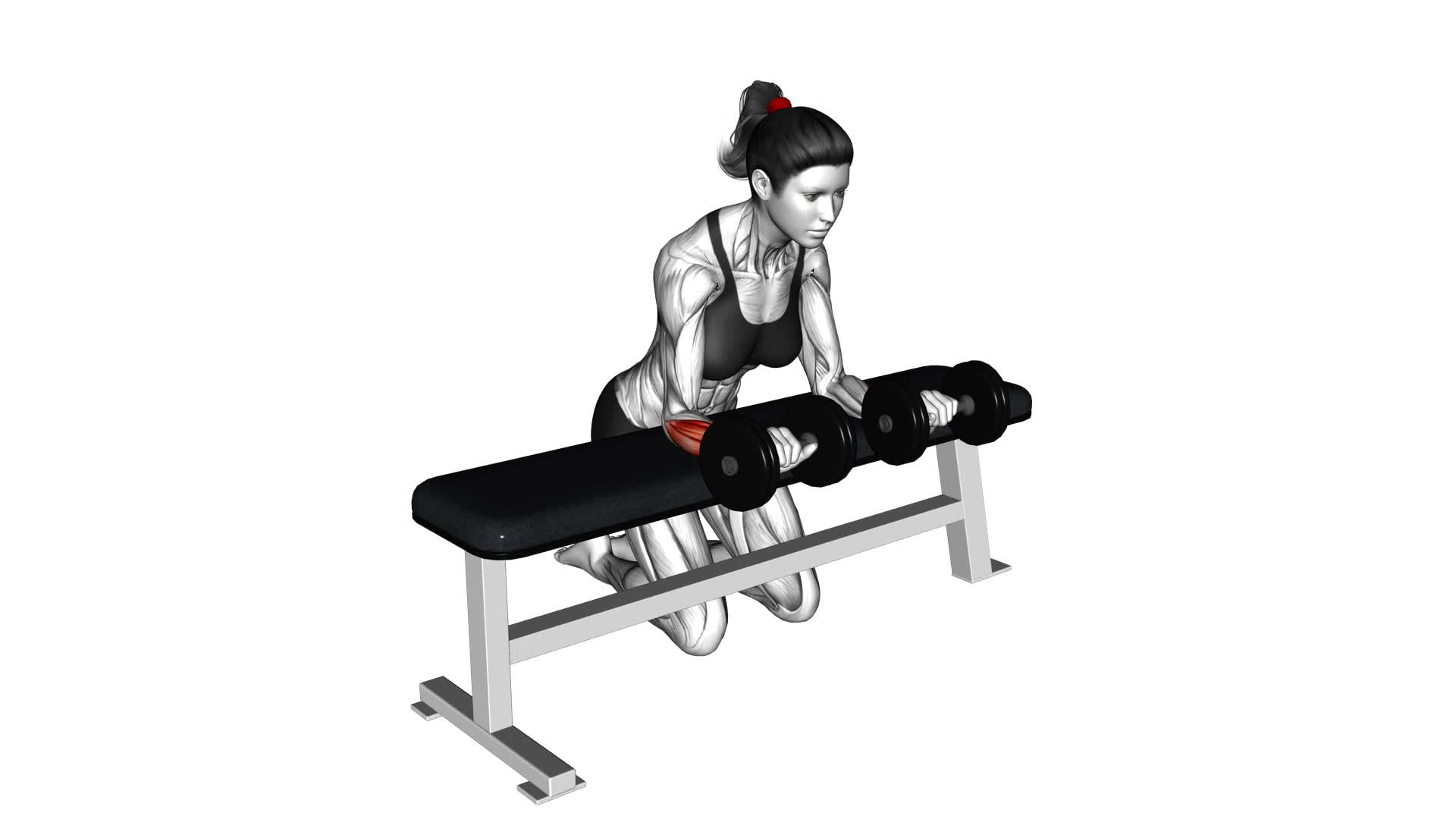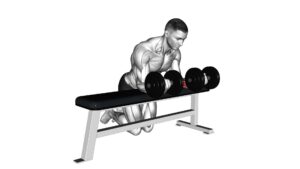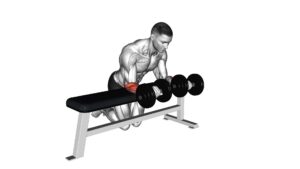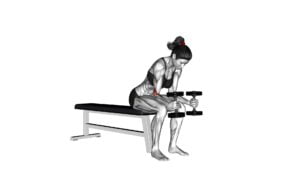Dumbbell Over Bench Wrist Curl (female) – Video Exercise Guide & Tips

Want to strengthen your wrists and improve your grip strength? Look no further than the Dumbbell Over Bench Wrist Curl.
Watch This Exercise Video
In this video exercise guide, we'll show you how to properly perform this exercise to maximize its benefits. You'll learn step-by-step instructions, common mistakes to avoid, and tips for increasing the intensity of your workout.
Whether you're a beginner or have wrist injuries, we've got safety precautions and modifications for you.
Let's get started!
Key Takeaways
- Dumbbell over bench wrist curl improves wrist strength and flexibility.
- It targets lower arm muscles and enhances grip strength.
- The exercise can be modified for beginners or individuals with wrist injuries.
- Proper form is essential to minimize the risk of injury.
Benefits of the Dumbbell Over Bench Wrist Curl
To maximize your gains, the Dumbbell Over Bench Wrist Curl offers a multitude of benefits for female athletes. One of the key benefits is the improvement of wrist strength and flexibility. By engaging the muscles in your wrists and forearms, this exercise helps to strengthen the tendons and ligaments, reducing the risk of injury during sports and daily activities.
Additionally, the Dumbbell Over Bench Wrist Curl targets the muscles in the lower arms, particularly the flexor muscles, which are responsible for wrist and finger movements. This exercise can enhance grip strength, allowing you to have a firmer hold on various objects and enhancing your performance in activities that require gripping, such as weightlifting, tennis, and rock climbing.
Another benefit of the Dumbbell Over Bench Wrist Curl is its versatility. This exercise can be performed in different variations to target specific muscle groups. For example, by adjusting the angle of the bench or using different grips, you can focus on the forearm muscles from different angles, providing a well-rounded workout for your wrists and forearms.
Now that you understand the benefits of the Dumbbell Over Bench Wrist Curl, let's move on to discussing the equipment needed for this exercise.
Equipment Needed for the Exercise
To perform the Dumbbell Over Bench Wrist Curl, you'll need some essential exercise equipment. This includes a bench and a dumbbell.
The recommended weight options for the dumbbell will depend on your fitness level and strength. It's important to choose a weight that challenges you, but still allows you to maintain proper form throughout the exercise.
Essential Exercise Equipment
You will need dumbbells for the Dumbbell Over Bench Wrist Curl exercise.
When it comes to essential exercise equipment, proper form is of utmost importance. It ensures that you perform exercises correctly, minimizing the risk of injury and maximizing the effectiveness of your workout.
Different types of essential exercise equipment cater to specific fitness goals, allowing you to target different muscle groups and achieve desired results. Here are four examples:
- Resistance bands: Ideal for strength training, they provide resistance throughout the entire range of motion, challenging your muscles and promoting muscle growth.
- Jump ropes: Excellent for cardio workouts, they improve cardiovascular endurance, coordination, and agility.
- Stability balls: Perfect for core training, they engage your core muscles, improve balance, and enhance stability.
- Kettlebells: Great for functional training, they work multiple muscle groups simultaneously, improving strength, power, and flexibility.
Remember to choose the right equipment for your fitness goals to maximize your workout's effectiveness.
Recommended Weight Options
For the Dumbbell Over Bench Wrist Curl exercise, you'll need to consider the recommended weight options and the equipment needed.
When it comes to selecting the ideal weight range for this exercise, it's important to start with a weight that challenges you but allows you to maintain proper form and technique. A good starting point for beginners is around 5 to 10 pounds, and for more advanced individuals, 10 to 15 pounds or even higher can be used. As you progress, you can increase the weight gradually to continue challenging your muscles.
It's recommended to use dumbbells for this exercise, as they provide a more balanced and controlled movement. Remember to always consult a fitness professional for personalized guidance on weight selection and progression options.
Safety Precautions and Setup
When setting up for the Dumbbell Over Bench Wrist Curl exercise, ensure that you have the necessary equipment and take the appropriate safety precautions. Here are some safety measures and proper setup guidelines to follow:
- Use a flat bench and adjust it to a height that allows your arms to comfortably extend over the edge.
- Place a dumbbell on the floor next to the bench.
- Sit on the bench and position your forearms on the bench, palms facing up, with your wrists hanging off the edge.
- Grasp the dumbbell with an underhand grip and lift it up towards your forearms by flexing your wrists.
- Keep your upper arms and elbows stationary throughout the exercise.
- Use a weight that allows you to maintain proper form and control.
Following these safety measures and proper setup will help you perform the Dumbbell Over Bench Wrist Curl exercise effectively and safely.
Now let's move on to the step-by-step guide for performing the exercise.
Step-By-Step Guide to Performing the Dumbbell Over Bench Wrist Curl
To perform the dumbbell over bench wrist curl with proper form, start by sitting on a bench with your forearms resting on the bench and your palms facing up. Hold a dumbbell in each hand and let your wrists hang off the edge of the bench.
Curl your wrists upward, contracting the forearm muscles, then slowly lower them back down. You can adjust the weight and resistance by using different dumbbell sizes or adding wrist weights for more challenge.
This exercise helps to strengthen the forearm muscles and improve grip strength, and there are variations such as using an EZ bar or performing the exercise standing up for added difficulty.
Proper Form Techniques
To perform the dumbbell over bench wrist curl exercise correctly, start by grabbing a pair of dumbbells with a comfortable weight. Here are some proper form techniques to keep in mind:
- Sit on a bench with your feet flat on the floor and your forearms resting on the bench.
- Hold the dumbbells with an overhand grip and extend your wrists so that the dumbbells are hanging in front of you.
- Slowly lower the dumbbells towards the floor by bending your wrists.
- Pause for a moment and then raise the dumbbells back up by extending your wrists.
Common mistakes to avoid include using too much weight, allowing your wrists to bend too much, and using momentum to lift the weight. Remember to focus on using controlled movements and maintaining proper form throughout the exercise.
Now, let's move on to discussing weight and resistance options.
Weight and Resistance Options
Continue the discussion from the previous subtopic by choosing a weight and resistance option that suits your fitness level and goals for the dumbbell over bench wrist curl exercise.
When selecting a weight for this exercise, it's important to consider your current strength and endurance. For beginners, it's recommended to start with lighter weights, such as 2-5 pounds, to ensure proper form and reduce the risk of injury.
As you progress and feel more comfortable, you can gradually increase the weight to challenge your muscles. Intermediate and advanced individuals can opt for heavier weights, ranging from 5-15 pounds, to further enhance strength and muscle development.
Remember to always listen to your body and choose a weight that allows you to perform the exercise with proper form and control.
Benefits and Variations
For optimal results and to target your wrist flexors, perform the dumbbell over bench wrist curl exercise with a neutral grip. This variation of the wrist curl has several benefits and can be modified to suit your fitness level.
Benefits of wrist exercises:
- Strengthens the muscles in your forearms and wrists, improving grip strength.
- Enhances wrist stability and flexibility, reducing the risk of injuries.
- Helps with daily activities that require wrist movement, such as typing or lifting objects.
- Can be beneficial for athletes in sports that require strong wrists, such as tennis or weightlifting.
Different variations of wrist curls:
- Reverse wrist curls: Targets the extensor muscles on the back of the forearm.
- Barbell wrist curls: Increases the load and intensity of the exercise.
- One-arm wrist curls: Allows for unilateral training and focuses on each wrist individually.
- Wrist roller: Utilizes a cylindrical device to improve grip strength and forearm endurance.
Common Mistakes to Avoid During the Exercise
Avoidance of improper form is crucial for maximizing the effectiveness of the Dumbbell Over Bench Wrist Curl exercise. To ensure you're performing this exercise correctly and avoiding common mistakes, it's important to follow proper form techniques.
One common mistake to avoid is using too much weight. It's important to start with a weight that you can comfortably lift and control throughout the exercise. Using excessive weight can lead to poor form and increase the risk of injury.
Another mistake to avoid is lifting the elbows off the bench. Keep your elbows firmly planted on the bench throughout the exercise. Lifting the elbows can put unnecessary strain on the wrists and decrease the effectiveness of the exercise.
Additionally, avoid bending the wrists too far backward or forward. Keep your wrists in a neutral position throughout the movement. This will target the muscles in the forearms more effectively and reduce the risk of wrist strain.
Lastly, don't rush through the exercise. Perform each repetition with controlled movements, focusing on squeezing the muscles in the forearms. Rushing can lead to poor form and reduce the overall effectiveness of the exercise.
Tips for Increasing the Intensity of the Workout
To further challenge yourself and increase the effectiveness of the Dumbbell Over Bench Wrist Curl exercise, you can gradually add more weight or perform the exercise more frequently. Increasing difficulty will help you continue making progress and achieve your fitness goals.
Here are some tips to enhance the intensity of your workout:
- Gradually increase the weight: Start with a weight that challenges you but allows you to maintain proper form. As you become comfortable, gradually increase the weight to continue challenging your muscles.
- Perform additional sets: Instead of performing the exercise once or twice, try adding an extra set. This will increase the overall volume of your workout and provide a greater stimulus for muscle growth.
- Increase the number of repetitions: If you feel that you can handle more repetitions with good form, gradually increase the number of repetitions per set. This will help build muscular endurance and improve your overall strength.
- Focus on proper breathing techniques: Proper breathing is essential for maximizing the effectiveness of any exercise. Inhale before starting the movement and exhale as you curl your wrists upwards. This will help stabilize your core and enhance your overall strength.
By implementing these tips, you can take your Dumbbell Over Bench Wrist Curl exercise to the next level. However, it's important to remember that safety should always be a priority.
In the next section, we'll discuss safety precautions and modifications for beginners or those with wrist injuries.
Safety Precautions and Modifications for Beginners or Those With Wrist Injuries
To ensure safety and accommodate beginners or individuals with wrist injuries, employ modifications during the Dumbbell Over Bench Wrist Curl exercise. For beginners, it's recommended to start with lighter dumbbells to allow for proper form and technique. This will help prevent strain on the wrists and ensure a gradual progression in strength. Additionally, beginners can perform the exercise with their palms facing up instead of down. This modification reduces the stress on the wrists and allows for a more comfortable and controlled movement.
For individuals with wrist injuries, modifications are necessary to avoid further damage and promote healing. One modification is to perform the exercise using a wrist brace or support. This provides stability and reduces the risk of aggravating the injury. Another modification is to reduce the range of motion by not fully extending the wrists. This limits the strain on the injured area while still targeting the forearm muscles. It's important to listen to your body and stop the exercise if you experience any pain or discomfort.
Frequently Asked Questions
How Many Sets and Repetitions Should I Do for the Dumbbell Over Bench Wrist Curl Exercise?
To properly perform the dumbbell over bench wrist curl exercise, you should aim for 3 sets of 10 to 12 repetitions. This exercise targets the muscles in your forearms, helping to strengthen and tone them.
It's important to maintain proper form throughout the exercise, keeping your wrists straight and avoiding any jerky movements. Common mistakes to avoid include using too heavy of a weight and not fully extending your wrists at the top of the movement.
What Muscles Does the Dumbbell Over Bench Wrist Curl Target?
The dumbbell over bench wrist curl targets the muscles in your forearms and wrists. This exercise can help strengthen your grip and improve overall wrist stability. By performing this exercise, you can benefit from increased forearm strength and improved performance in activities that require wrist mobility and stability.
Variations of this exercise include using different weights or performing the exercise with a barbell instead of dumbbells.
Can I Use a Barbell Instead of Dumbbells for This Exercise?
Yes, you can use a barbell instead of dumbbells for the wrist curl exercise. Using a barbell offers several benefits for this exercise.
It allows for a greater range of motion and allows you to lift heavier weights. This can help to increase wrist strength and muscle development.
However, be sure to maintain proper form and start with lighter weights to avoid injury. Always consult a fitness professional for guidance.
How Often Should I Perform the Dumbbell Over Bench Wrist Curl Exercise?
To get optimal results from the dumbbell over bench wrist curl exercise, it's important to perform it regularly. The frequency of this exercise depends on your fitness goals and current level of strength.
Generally, it's recommended to incorporate wrist curl exercises into your routine 2-3 times a week. This will allow your wrists and forearms to build strength and endurance over time.
Remember to start with lighter weights and gradually increase as you progress to avoid injury.
Are There Any Alternatives or Variations to the Dumbbell Over Bench Wrist Curl Exercise That I Can Try?
Looking for alternative exercises or variations to the dumbbell over bench wrist curl? You're in luck! There are several options you can try to target your wrist muscles.
Consider incorporating exercises like wrist curls with a barbell, reverse wrist curls, or wrist roller exercises into your routine. These variations will help to add variety and challenge to your wrist training, allowing you to continue making progress.
Give them a try and see which ones work best for you!
Conclusion
In conclusion, the dumbbell over bench wrist curl is an effective exercise for strengthening the wrists and forearms. By following the step-by-step guide and avoiding common mistakes, individuals can safely perform this exercise. Increasing the intensity can be achieved by adding more weight or performing more reps.
Beginners or those with wrist injuries should take necessary precautions and modify the exercise as needed.
Overall, incorporating the dumbbell over bench wrist curl into your workout routine can lead to improved wrist strength and stability.

Author
Years ago, the spark of my life’s passion ignited in my mind the moment I stepped into the local gym for the first time. The inaugural bead of perspiration, the initial endeavor, the very first surge of endorphins, and a sense of pride that washed over me post-workout marked the beginning of my deep-seated interest in strength sports, fitness, and sports nutrition. This very curiosity blossomed rapidly into a profound fascination, propelling me to earn a Master’s degree in Physical Education from the Academy of Physical Education in Krakow, followed by a Sports Manager diploma from the Jagiellonian University. My journey of growth led me to gain more specialized qualifications, such as being a certified personal trainer with a focus on sports dietetics, a lifeguard, and an instructor for wellness and corrective gymnastics. Theoretical knowledge paired seamlessly with practical experience, reinforcing my belief that the transformation of individuals under my guidance was also a reflection of my personal growth. This belief holds true even today. Each day, I strive to push the boundaries and explore new realms. These realms gently elevate me to greater heights. The unique combination of passion for my field and the continuous quest for growth fuels my drive to break new ground.







